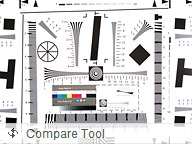Samsung I9300 Galaxy S III vs. HTC One X: Alien vs. Predator
Alien vs. Predator
Camera interfaces
Comparing the camera interfaces on the Samsung Galaxy S III and the HTC One X, two clearly different approaches can be observed that veer away from stock Android. The TouchWiz camera UI on the Samsung Galaxy S III is customizable and fairly intuitive to use. While the ImageSense camera suite found on HTC's One series is a unified UI for both the camera and the camcorder.
With the Samsung Galaxy S III you get two shortcut bars on each side of the viewfinder - on the right you get the still camera / camcorder switch, a virtual shutter key and the gallery shortcut (which is a thumbnail of the last photo taken).
On the left you get several controls and the good news is that you can pick any five shortcuts to put there - you can easily have all commonly used features just a tap away.
We like the look on the HTC One X - the right-hand side features the Effects button, shutter key, camcorder record key and a shortcut to the gallery that shows the last photo taken. On the left is the flash setting toggle, general settings and shot mode (we'll get back to that in a moment).




The TouchWiz vs. ImageSense camera interfaces
Both apps offer simultaneous video and image capture, meaning that once you've started recording a clip you also get an on-screen shutter that enables image capture. The produced results are in full 8 MP resolution but with an aspect ratio of 16:9, instead of 4:3, to match the video aspect ratio.
Both devices also offer Burst mode - just hold the virtual shutter and the device will start snapping away at around 3 fps at full 8 MP resolution. The difference here is that the HTC One X snaps shots until you hold the button and then lets you choose the keepers, while the Galaxy S III shoots up to 20 photos and automatically stores all of them in your gallery.
We like the effects HTC have implemented into ImageSense. There are lots of Instagram-like options such as Vignette, Blur, etc. while the Galaxy S III is limited to just Sepia, Black and White, and Negative. There are plenty of apps in the Android Market for adding various effects to your photos anyway.
Image quality
Both the Samsung Galaxy S III and the HTC One X feature 8 MP cameras that are capable of taking photos at max resolution of 3264x2448 pixels. Both feature single LED on the back and, thanks to their zippy processors, both offer 1080p and 720p video recording with simultaneous image capture. The lens used in the Galaxy S III has a slightly wider filed of view compared to the One X.
Update: We reshot the camera samples so the two contestants are on equal footing. It doesn't really change much in terms of image quality but it certainly makes their images easier to compare.
We added the Galaxy S II to the first round of tests for good measure. As you can see from the crops, in good lighting the Galaxy S III tends to produce images with more detail than both its predecessor and the HTC One X.
The processing of the new Samsung flagship is much more mature too - it introduces very few oversharpening artifacts and loses little detail, while still managing to keep the noise under control. The One X on the other hand is a bit too aggressive with the sharpening and isn't doing nearly as good at removing the noise.
Both contenders tend to oversaturate colors (particularly green), but the Galaxy S III comes a little closer to reality.



Samsung Galaxy S III vs. HTC One X vs. Samsung Galaxy S II
And there go a couple of more shots, which tell a similar story. Differences aren't huge, but the Galaxy S III still has an edge.


Samsung Galaxy S III vs. HTC One X
We also tested the photos that the One X and the Galaxy S III captured, while recording video. They are 6 megapixel stills in 16:9 aspect ratio.
It's interesting to note that the HTC One X frames pictures differently from the video so you always end up with a result with a wider field of view. The Galaxy S III in-video shots have the same framing as the video.
In good light, the two smartphones resolve about the same amount of detail here, but the One X has better contrast and it sharpens its images more aggressively, which makes its output look punchier. The Galaxy S III still has slightly better color reproduction, though.
Things get vastly different in low light, when the bright F/2.0 optics of One X count big time. In such conditions the HTC flagship crushes its opponent, producing images with far less noise and much better contrast.




Samsung Galaxy S III (top row) vs. HTC One X (bottom row): 16:9 6 MP photos
Most devices out there offer HDR mode straight out of the camera app and so do the Galaxy S III and HTC One X. The One X produces more dramatic looking results, while the Galaxy S III has a pretty subtle approach. Which solution is better is strictly a matter of personal preference, but the Galaxy S III does resolve more detail and its highlights aren't as exaggerated.




Samsung Galaxy S III (top row) vs. HTC One X (bottom row): HDR Off/On samples
We've prepared a couple of macro samples. Things are extremely close here with the two smartphones trading blows from shot to shot.






Samsung Galaxy S III vs. HTC One X: Macro shooting
Photo quality comparison
We have the Samsung Galaxy S III and HTC One X in our Photo comparison tool. The tool's page will give you the full details and it's where you can make the most comprehensive observations on the cameras involved in this shootout.
The Galaxy S III uses its resolution advantage to easily outdo the HTC One X in the first two charts. The two are much more evenly matched on the last studio challenge, but the S III shot has far less noise there.



Samsung Galaxy S III vs. HTC One X vs. Samsung Galaxy S II in our Photo Compare Tool
Reader comments
- DonNasi
- 27 Dec 2016
- 0TF
Htc one x the king of all phones
- wasem
- 24 Nov 2014
- Nrf
Samsung s3 is better than one x in cpu, camera, touchwiz, The sounds but htc one x had slow cpu and very bad, the camera is bad and no touch wiz
- AnonD-250641
- 12 May 2014
- Trk
HTC one x is Simply Best